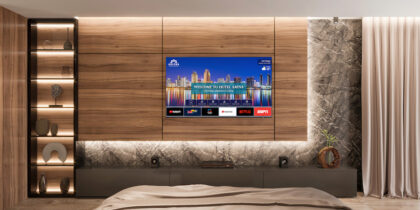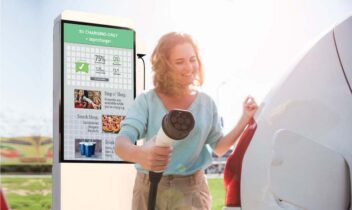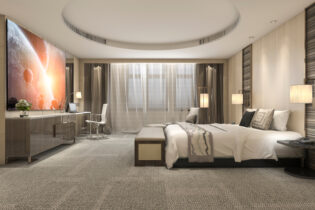Wi-Fi access inside business locations used to be a perk — something coffee shops offered to encourage lingering and hotels touted as a value-add. Now it’s a consumer expectation.
Cellular service isn’t always reliable indoors, and data plans can get expensive, so people expect businesses to provide the undisrupted Wi-Fi connectivity they need to manage work and life. By 2019, Wi-Fi will carry up to 60 percent of all mobile data traffic, according to Juniper Research.
This isn’t difficult for most businesses. But for convention centers, sports venues, and other locations with high density Wi-Fi needs, reliability can be tricky. When large numbers of users attempt to connect inside wide, open floor plans, there’s the potential for co-channel interference — a phenomenon that occurs when multiple access points using the same radio frequency are within a device’s line of sight.
This had become a big problem for the Grand Wayne Convention Center (GWCC) in Fort Wayne.
“The majority of our biggest conventions are repeat customers, some of whom go back 30 years,” says Rick Browning, technical director for GWCC. “In the last two years, it became painfully obvious that clients were not happy with the wireless limitations, and a number of our biggest conventions finally said they couldn’t come back unless we did something about it.”
Solving the High Density Wi-Fi Challenge
One of the most popular meeting facilities in Indiana, GWCC’s 225,000 square-foot building hosts 220,000 guests each year for more than 300 events and 50 conventions. But the building’s 12-year-old wireless network couldn’t handle the increased number of wireless users. Once 30 or more devices connected to the network, it became sluggish and unreliable, and IT staff had to manually set up local access points just to support events.
This was frustrating for customers and for GWCC staffers, who needed Wi-Fi to do their jobs.
Browning partnered with Samsung and Applied Technology Group (ATG), a Fort Wayne company that implements enterprise technology solutions, to build a high density Wi-Fi network that meets his organization’s unique needs.
The solution includes:
-
Samsung WLAN devices: One large controller supports up to 10,000 users and more than 40 access points throughout the building.
-
External antennas: To eliminate co-channel interference in large, open areas — some of which have 30-foot-high ceilings — ATG installed external TerraWave antennas that focus coverage patterns from each access point and reduce signal overlap.
-
Samsung AirEqualizer: Many access points on the market slow down to the slowest performing connected device. But the AirEqualizer technology in Samsung access points enables networks to communicate with slower and faster devices separately, ensuring the highest speed possible for each device.
Now GWCC can offer free Wi-Fi, a service that differentiates it from competitors who charge for wireless, without draining IT resources or letting customers down.
A Whole New World of Wi-Fi
Stakes were high for the new solution’s big debut. Two weeks after implementation began, Fort Wayne’s mayor gave his State of the City address at GWCC, and a local television station streamed the event live. Browning was prepared for problems and had his team ready to manually set up local area networks like they’d done for so many events in the past.
“When the event started, I dialed up the live stream and walked the entire building, and didn’t see one dropout,” explains Browning. “I knew then that it was going to work great.”
At one of GWCC’s largest events — the Willow Creek Global Leadership Conference — 1,200 attendees connected more than 700 devices at the same time. “We got no complaints,” says Browning. “In fact, we got some pretty nice Twitter comments about the great free Wi-Fi we offer, which is better than somebody coming up and saying it works well. To have that on social media makes a big difference for our brand.”
Keeping the Wi-Fi running has required very little effort from Browning’s team, and so far there have been no hiccups with the technology. If an access point goes down, GWCC gets an alert via email and can fix the problem immediately.
“In the past, it was always a crapshoot each morning about whether the convention that day would complain about the wireless or whether staff would have trouble connecting,” says Browning. “Now I don’t even think about it. I know it’s going to work, and the antenna placement enables us to keep all of our wireless energy inside the building.”
For more on GWCC’s high density Wi-Fi solution, read the in-depth case study.







